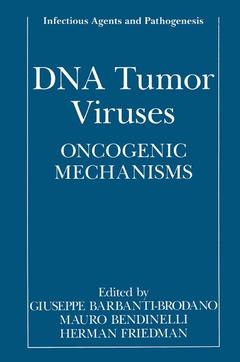DNA Tumor Viruses, Softcover reprint of the original 1st ed. 1995 Oncogenic Mechanisms Infectious Agents and Pathogenesis Series
Langue : Anglais

DNA tumor viruses have long been useful experimental models of carcinogenesis and have elucidated several important mechanisms of cell transformation. Re search in recent years has shown that human tumors have a multifactorial nature and that some DNA tumor viruses may playa key role in their etiology. The aim of this book is to assess our knowledge of DNA tumor viruses by reviewing animal models, mechanisms of transformation, association with human tumors, and possi bilities of prevention and control by vaccination. Animal models of tumor virology have contributed significantly to our under standing of the epidemiology and pathogenesis of virus-induced tumors. Bovine papillomaviruses induce papillomas in the intestine of cattle. The papillomas undergo a transition to carcinomas in cows feeding on bracken fern, which pro duces a toxin with radiomimetic and immunosuppressive functions. This example of cooperation between a virus and chemical carcinogens parallels the cooperative role of human papillomaviruses (HPVs) and herpes simplex virus type 2 (HSV-2) with environmental carcinogens in the pathogenesis of cervical cancer. Likewise, hepatocarcinomas appearing in woodchucks chronically infected by woodchuck hepatitis virus (WIN) provide strong support for the relationship between hepatitis B virus (HBV) infection and human hepatocellular carcinoma. Also, the fact that WIN DNA integrates closely to cellular oncogenes suggests a possible molecular mechanism for the tumorigenesis induced by HBV.
1. The Hamster Polyomavirus.- 2. Simian Virus 40 Large T Antigen Induces Chromosome Damage That Precedes and Coincides with Complete Neoplastic Transformation.- 3. Transformation by Polyomaviruses: Role of Tumor Suppressor Proteins.- 4. Association of BK and JC Human Polyomaviruses and SV40 with Human Tumors.- 5. Association of Simian Virus 40 with Rodent and Human Mesotheliomas.- 6. Immortalization of Keratinocytes by Human Papillomaviruses.- 7. Cooperation between Bovine Papillomaviruses and Dietary Carcinogens in Cancers of Cattle.- 8. Papillomaviruses as Promoting Agents in Human Epithelial Tumors.- 9. Vaccines against Human Papillomaviruses and Associated Tumors.- 10. The Complex Role of Hepatitis B Virus in Human Hepatocarcinogenesis.- 11. Transformation and Tumorigenesis Mediated by the Adenovirus E1A and E1B Oncogenes.- 12. Current Developments in the Molecular Biology of Marek’s Disease Virus.- 13. Oncogenic Transformation of T Cells by Herpesvirus saimiri.- 14. Transformation and Mutagenic Effects Induced by Herpes Simplex Virus Types 1 and 2.- 15. Herpes Simplex Virus as a Cooperating Agent in Human Genital Carcinogenesis.- 16. Human Cytomegalovirus: Aspects of Viral Morphogenesis and of Processing and Transport of Viral Glycoproteins.- 17. Association of Human Herpesvirus 6 with Human Tumors.- 18. Molecular Mechanisms of Transformation by Epstein-Barr Virus.- 19. Epstein-Barr Virus: Mechanisms of Oncogenesis.- 20. Association of Epstein-Barr Virus with Hodgkin’s Disease.- 21. The Development of Epstein-Barr Virus Vaccines.
Date de parution : 06-2013
Ouvrage de 428 p.
15.2x22.9 cm
Thèmes de DNA Tumor Viruses :
Mots-clés :
© 2024 LAVOISIER S.A.S.



